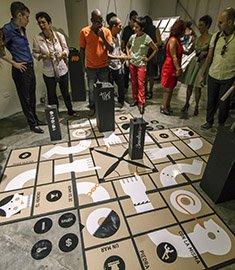
Hotel Inglaterra LH  3
3
The original nucleus of the hotel dates back to 1856 and was later expanded in 1891 with the addition of two adjacent properties. The last floor was built in 1915. This is Cuba’s oldest hotel and has …
 EclecticAdmission: NoneROOMS: 83Trocadero 55, entre Prado y Zulueta
EclecticAdmission: NoneROOMS: 83Trocadero 55, entre Prado y Zulueta 
Calle 23 LH  3
3
Calle 23, or 23rd Steet, is a central, busy street in El Vedado district. It begins at the sea and ends in a river, the Almendares. Its first five streets, from Malecón to L Street are known as La Ram …

Museo Numismático LH  3
3
Valued in approx 50 million dollars, the museum’s collections features medals, coins and banknotes from around the world, including an early 20 peso coin, the only one still existing of the ten produc …
 ModernAdmission: CUC 1Open: 9am-5pm Tues-SunObispo at 305, e/ Aguiar y Habana, Habana Vieja
ModernAdmission: CUC 1Open: 9am-5pm Tues-SunObispo at 305, e/ Aguiar y Habana, Habana Vieja 
Hotel Habana Libre LH  3
3
Located on the famous corner of 23 and L streets, the Habana Libre Hotel, with its 25 floors and 630 spacious rooms, stands majestically and offers an incomparable view of the bay. The building occupi …
 ModernL entre 23 y 25
ModernL entre 23 y 25 
Museo Nacional de la Danza LH  3
3
Opened in October, 1998, to coincide with the 50th anniversary of the National Ballet of Cuba, this museum features objects mainly from Alicia Alonso’s collection, as well as documentaries, costumes a …

El Torreón LH  3
3
Recently restored, El Torreón or as locals call it Castillito (literally, small castle), built in 1649 with blocks from the San Lázaro Quarry (where José Martí was sentenced to forced labor), was part …

Cruz Verde LH  3
3
The corner of Amargura and Mercaderes is known as Cruz Verde (Green Cross) due to a green-painted cross affixed to the northwest-facing cornerstone. The cross is one of twelve that were to be found al …

Alameda de Paula LH  3
3
The construction of the Alameda de Paula, one of Havana’s first promenades, was commissioned by Captain General Felipe de Fondesviela, member of the court of King Carlos III, and built by architect An …

Hotel Sevilla LH  3
3
After the city walls began to be demolished in 1863, construction works for a luxury hotel began on El Prado Avenue, one of the city’s most popular promenades. Manuel López and Urbano González, owners …
 OtherAdmission: NoneTrocadero 55, entre Prado y Zulueta
OtherAdmission: NoneTrocadero 55, entre Prado y Zulueta 
Museo Palacio de Gobierno – Cámara de Representantes LH  3
3
Immediately south of the Convento de San Francisco de Asís, the squat yet imposing neo-classical building raised atop stairs served as the original Cámara de Representantes—the Republican House of Rep …
 Neo-classicalAdmission: FreeOpen: 9:30am-5:30pm Tues-SunOficios #211 e/ Churruca y Muralla, Habana Vieja
Neo-classicalAdmission: FreeOpen: 9:30am-5:30pm Tues-SunOficios #211 e/ Churruca y Muralla, Habana Vieja 












